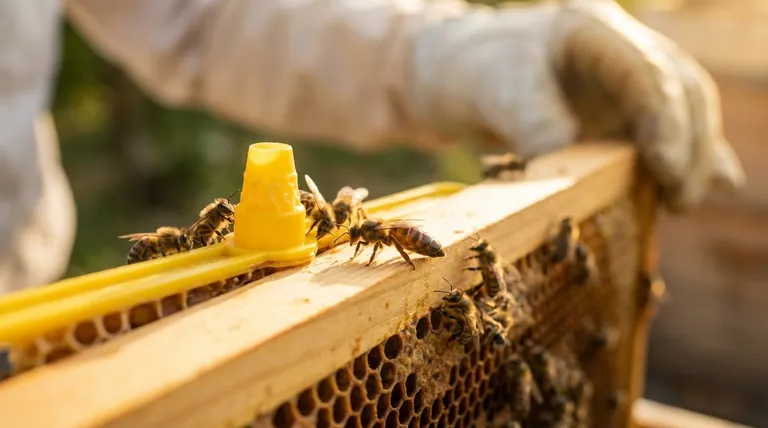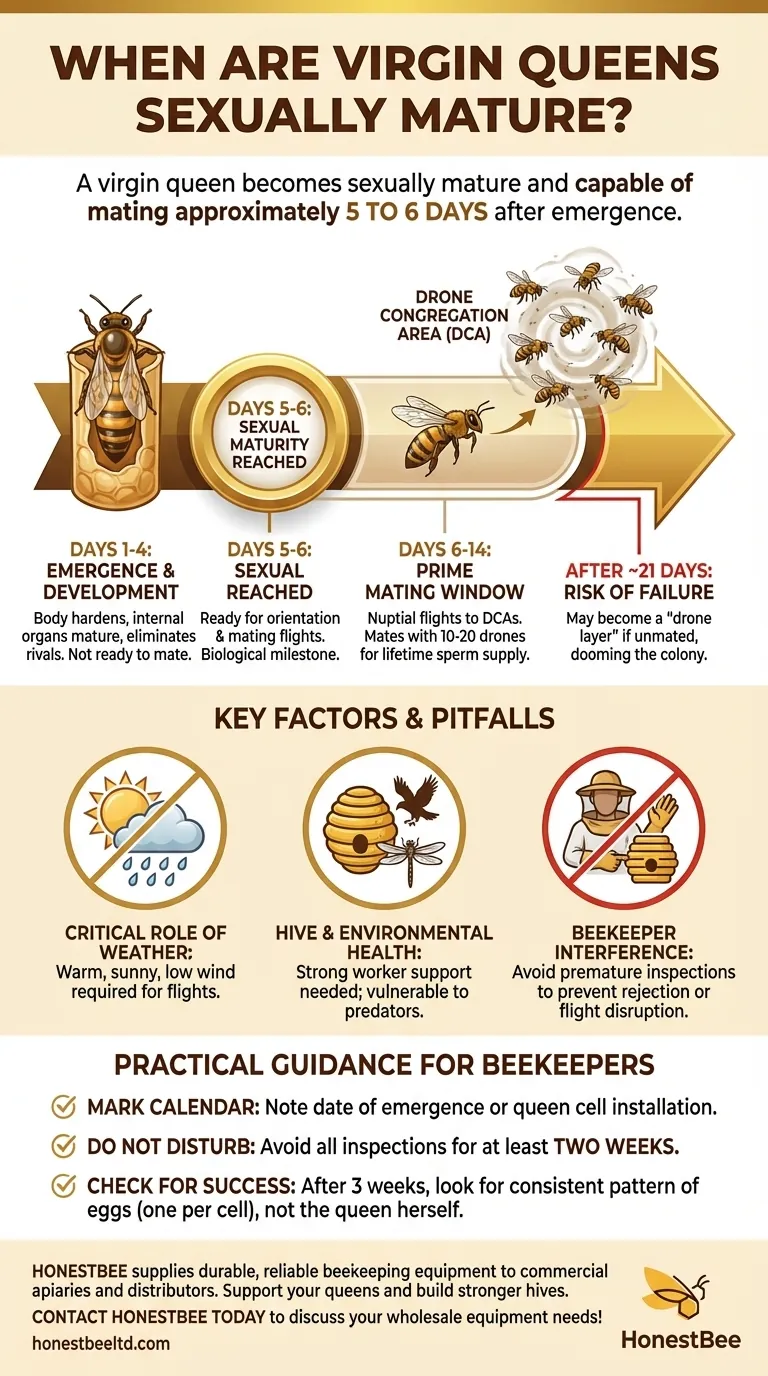In short, a virgin queen bee becomes sexually mature and capable of mating approximately 5 to 6 days after she emerges from her queen cell. This period allows her body to fully harden and prepare for the physically demanding nuptial flights that are critical for the colony's survival.
The age of sexual maturity is not just a date on a calendar; it marks the beginning of a brief, high-stakes window where the queen's successful mating determines the future health, productivity, and genetic viability of the entire hive.

The Journey to a Mated Queen
Understanding the queen's development from emergence to egg-laying is fundamental for any beekeeper. This process is a delicate sequence of biological triggers and environmental dependencies.
Phase 1: Emergence and Development (Days 1-4)
Immediately after emerging from her cell, a virgin queen is not yet ready to mate. Her exoskeleton is soft and she is focused on building strength.
During this time, she will assert her dominance by locating and destroying any rival queen cells or virgin queens in the hive. She is fed and tended to by worker bees as her internal reproductive organs complete their development.
Phase 2: The Mating Window (Days 5-14)
Around day 5 or 6, the queen reaches sexual maturity. This biological milestone signals that she is ready to begin the flights necessary for mating.
She will start by taking short orientation flights, typically on warm, sunny afternoons. These flights help her learn the hive's location and the surrounding landscape, preparing her for the longer nuptial flights to come.
The prime period for mating occurs between day 6 and day 14. The queen will fly to a "Drone Congregation Area" (DCA), an aerial location where thousands of drones from surrounding colonies gather, waiting to mate. She will mate with an average of 10-20 drones over several flights to collect enough sperm to last her entire life.
Key Factors and Common Pitfalls
A queen's successful mating is not guaranteed. Several external factors can lead to failure, which is catastrophic for the colony.
The Critical Role of Weather
Mating flights only occur in good weather, typically on sunny, warm afternoons with low winds. A prolonged period of rain, cold, or high winds can prevent a queen from flying.
If a queen is unable to mate within about three weeks of emerging, she loses her viability. She may become a "drone layer," laying only unfertilized eggs which develop into drones, dooming the colony.
Hive and Environmental Health
A strong population of worker bees is necessary to support the queen and the new brood she will eventually produce. A weak hive may not be able to properly care for her.
Furthermore, the queen is vulnerable to predators like birds and dragonflies during her flights.
Beekeeper Interference
One of the most common pitfalls is premature or excessive hive inspection. Disturbing the colony during this sensitive period can cause the workers to reject or harm the virgin queen, or it can disrupt her flight schedule.
Practical Guidance for Beekeepers
Knowing the queen's timeline allows you to manage your hives with minimal disruption and maximum chance of success.
- If you are requeening or have a recent swarm: Mark your calendar with the date the new queen emerged or the date you installed the queen cell.
- Do not disturb the hive: Avoid all inspections for at least two weeks after the queen is expected to have emerged. This gives her ample, undisturbed time to mature, orient, and mate.
- Check for success, not just the queen: After about three weeks, perform a quick inspection. Your goal is not to find the queen herself—which can be difficult and stressful for the hive—but to find evidence of her success: a consistent pattern of tiny, rice-like eggs, one per cell.
Understanding this critical window is the key to successfully managing new queens and ensuring the long-term prosperity of your colonies.
Summary Table:
| Key Phase | Timeline (Days After Emergence) | Key Activity |
|---|---|---|
| Development | 1 - 4 | Body hardening, internal organ maturation, eliminating rivals. |
| Sexual Maturity | 5 - 6 | Ready for orientation and mating flights. |
| Prime Mating Window | 6 - 14 | Takes nuptial flights to Drone Congregation Areas (DCAs). |
| Risk of Failure | After ~21 | May become a drone layer if mating is unsuccessful. |
Ensure your queens have the best chance for success. HONESTBEE supplies durable, reliable beekeeping equipment to commercial apiaries and distributors. From protective gear to hive tools, our wholesale-focused operations provide the essential supplies your operation needs to manage colonies effectively. Let us help you support your queens and build stronger hives.
Contact HONESTBEE today to discuss your wholesale equipment needs!
Visual Guide

Related Products
- Jenter Queen Rearing Kit Complete Set for Bee Breeding
- Nicot Queen Rearing Kit for Beekeeping and Grafting in Nicot System
- No Grafting Queen Rearing Kit: System for Royal Jelly Production and Queen Rearing
- Plastic Chinese Queen Grafting Tool for Bee Queen Rearing
- Brown Nicot Queen Cell Cups for Breeding Queen Bees Beekeeping
People Also Ask
- Why is raising queens beneficial for beekeepers? Gain Control Over Genetics and Costs
- How long does it take for a new queen to emerge, mate, and lay eggs? A Beekeeper's 10-14 Day Guide
- What genetic pathways differ in QE-queens? Unlocking the Master Controls of Queen Bee Biology
- What happens to the colony population during the 5–6 weeks after a new queen emerges? Understand the Natural Dip and Rebound
- What are the stages involved in queen raising? A Guide to Controlled, High-Quality Queen Production



















